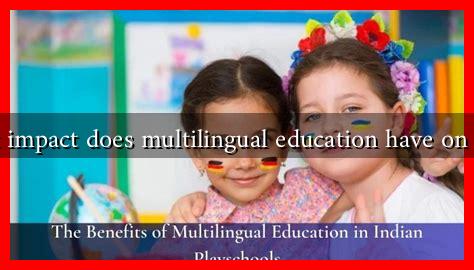-
Table of Contents
What Impact Does Multilingual Education Have on Girls?
Multilingual education has emerged as a significant area of focus in the global educational landscape, particularly in regions where multiple languages coexist. This approach not only enhances cognitive abilities but also plays a crucial role in empowering girls. In this article, we will explore the multifaceted impact of multilingual education on girls, examining its benefits, challenges, and real-world implications.
The Importance of Multilingual Education
Multilingual education refers to teaching in more than one language, which can include a combination of a local language, a national language, and an international language. This educational model is particularly beneficial in diverse societies where linguistic variety is the norm. The importance of multilingual education can be summarized as follows:
- Cognitive Development: Studies have shown that learning multiple languages enhances cognitive skills, including problem-solving and critical thinking.
- Cultural Awareness: Multilingual education fosters an appreciation for different cultures, promoting inclusivity and social cohesion.
- Economic Opportunities: Proficiency in multiple languages can open doors to better job prospects and economic mobility.
Empowerment Through Education
For girls, multilingual education can be a powerful tool for empowerment. Here are some ways it impacts their lives:
- Increased Access to Education: In many regions, girls face barriers to education due to cultural norms or economic constraints. Multilingual education can help bridge these gaps by making learning more accessible and relevant.
- Boosting Self-Confidence: Mastering multiple languages can enhance a girl’s self-esteem and confidence, enabling her to participate more actively in her community.
- Encouraging Leadership Skills: Girls who are educated in multiple languages often develop strong communication skills, which can lead to leadership opportunities in their communities.
Case Studies and Statistics
Several case studies illustrate the positive impact of multilingual education on girls:
- Case Study in India: A program in rural India introduced multilingual education in local schools, resulting in a 30% increase in girls’ enrollment. The program emphasized local languages alongside Hindi and English, making education more relatable and engaging for students.
- Statistics from Sub-Saharan Africa: According to a report by UNESCO, girls who receive education in their mother tongue are 50% more likely to complete primary school compared to those who do not.
- Impact in Canada: In Canada, bilingual education programs have shown that girls outperform boys in language proficiency tests, highlighting the effectiveness of multilingual education in fostering academic success.
Challenges to Multilingual Education for Girls
Despite its benefits, multilingual education also faces several challenges, particularly for girls:
- Resource Limitations: Many schools lack the necessary resources, such as trained teachers and educational materials, to implement effective multilingual programs.
- Cultural Resistance: In some communities, there may be resistance to teaching in multiple languages due to traditional beliefs or societal norms.
- Language Proficiency: Girls may struggle with language proficiency if they are not exposed to multiple languages at home, which can hinder their educational progress.
Conclusion
Multilingual education has a profound impact on girls, offering them opportunities for cognitive development, cultural awareness, and economic empowerment. While challenges remain, the benefits of this educational approach are undeniable. By fostering an environment where girls can learn in multiple languages, we not only enhance their educational outcomes but also contribute to a more equitable society. As we move forward, it is essential to advocate for policies that support multilingual education, ensuring that every girl has the chance to thrive in a multilingual world.
For further reading on the importance of multilingual education, you can visit UNESCO’s Multilingual Education page.

